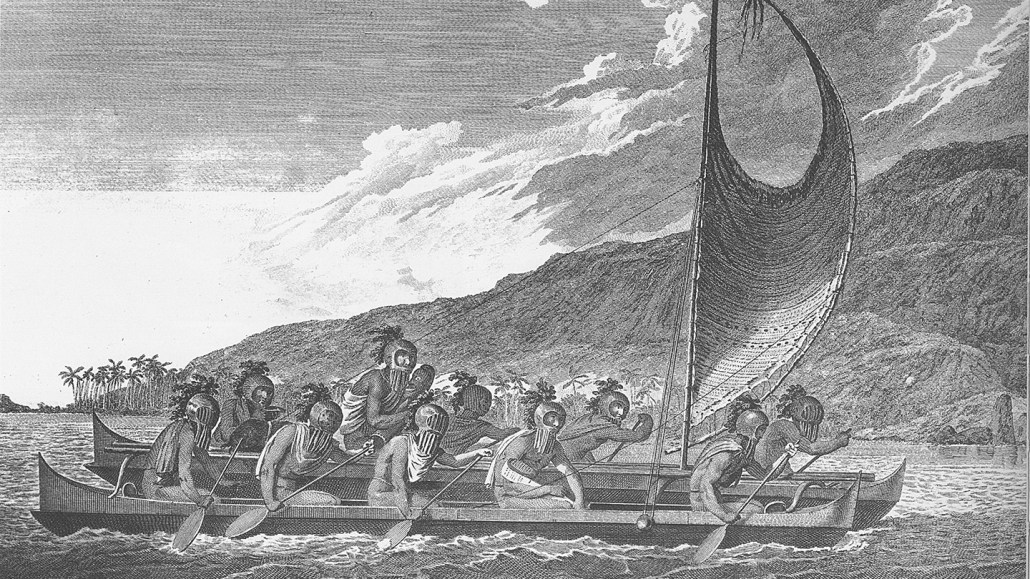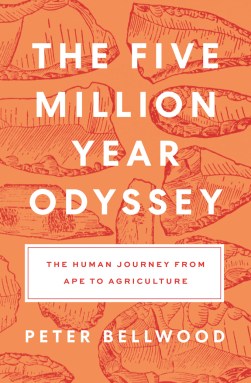‘The Five-Million-Year Odyssey’ reveals how migration shaped humankind

Extensive population movements, including sea voyages from Southeast Asia to Polynesia, have had big impacts on human cultures and languages, an archaeologist explains in a new book. In this depiction, Hawaiians navigate toward a meeting with European explorers who arrived in 1778.
John Webber/Wikimedia Commons

The Five-Million-Year Odyssey
Peter Bellwood
Princeton Univ., $29.95
Archaeologist Peter Bellwood’s academic odyssey wended from England to teaching posts halfway around the world, first in New Zealand and then in Australia. For more than 50 years, he has studied how humans settled islands from Southeast Asia to Polynesia.
So it’s fitting that his new book, a plain-English summary of what’s known and what’s not about the evolution of humans and our ancestors, emphasizes movement. In The Five-Million-Year Odyssey, Bellwood examines a parade of species in the human evolutionary family — he collectively refers to them as hominins, whereas some others (including Science News) use the term hominids (SN: 9/15/21) — and tracks their migrations across land and sea. He marshals evidence indicating that hominids in motion continually shifted the direction of biological and cultural evolution.
Throughout his tour, Bellwood presents his own take on contested topics. But when available evidence leaves a debate unresolved, he says so. Consider the earliest hominids. Species from at least 4.4 million years ago or more whose hominid status is controversial, such as Ardipithecus ramidus, get a brief mention. Bellwood renders no verdict on whether those finds come from early hominids or ancient apes. He focuses instead on African australopithecines, a set of upright but partly apelike species thought to have included populations that evolved into members of our own genus, Homo, around 2.5 million to 3 million years ago. Bellwood hammers home the point that stone-tool making by the last australopithecines, the first Homo groups or both contributed to the evolution of bigger brains in our ancestors.
The action speeds up when Homo erectus becomes the first known hominid to leave Africa, roughly 2 million years ago. Questions remain, Bellwood writes, about how many such migrations occurred and whether this humanlike species reached distant islands such as Flores in Indonesia, perhaps giving rise to small hominids called hobbits, or Homo floresiensis (SN: 3/30/16). What’s clear is that H. erectus groups journeyed across mainland Asia and at least as far as the Indonesian island of Java.
Intercontinental migrations flourished after Homo sapiens debuted, around 300,000 years ago in Africa. Bellwood regards H. sapiens, Neandertals and Denisovans as distinct species that interbred in certain parts of Asia and Europe. He suggests that Neandertals disappeared around 40,000 years ago as they mated with members of more numerous H. sapiens populations, leaving a genetic legacy in people today. But he does not address an opposing argument that different Homo populations at this time, including Neandertals, were too closely related to have been separate species and that it was intermittent mating among these mobile groups that drove the evolution of present-day humans (SN: 6/5/21).
Bellwood gives considerable attention to the rise of food production and domestication in Europe and Asia after around 9,000 years ago. He builds on an argument, derived from his 2004 book First Farmers, that expanding populations of early cultivators migrated to new lands in such great numbers that they spread major language families with them. For instance, farmers in what’s now Turkey spread Indo-European languages into much of Europe sometime after roughly 8,000 years ago, Bellwood contends.
He rejects a recent alternative proposal, based on ancient DNA evidence, that horse-riding herders of Central Asia’s Yamnaya culture brought their traditions and Indo-European tongues to Europe around 5,000 years ago (SN: 11/15/17). Too few Yamnaya immigrated to impose a new language on European communities, Bellwood says. Similarly, he argues, ancient Eurasian conquerors, from Alexander the Great to Roman emperors, couldn’t get speakers of regional languages to adopt new ones spoken by their outnumbered military masters.
Bellwood rounds out his evolutionary odyssey with a reconstruction of how early agricultural populations expanded through East Asia and beyond, to Australia, a string of Pacific islands and the Americas. Between about 4,000 and 750 years ago, for instance, sea-faring farmers spread Austronesian languages from southern China and Taiwan to Madagascar in the west and Polynesia in the east. Precisely how they accomplished that remarkable feat remains a puzzle.
Disappointingly, Bellwood doesn’t weigh in on a recent archaeological argument that ancient societies were more flexible and complex than long assumed (SN: 11/9/21). On the plus side, his evolutionary odyssey moves along at a brisk pace and, like our ancestors, covers a lot of ground.
Buy The Five-Million-Year Odyssey from Bookshop.org. Science News is a Bookshop.org affiliate and will earn a commission on purchases made from links in this article.







